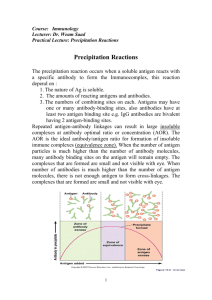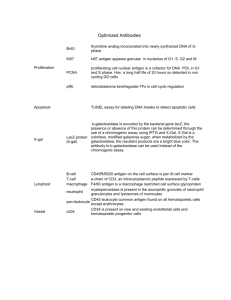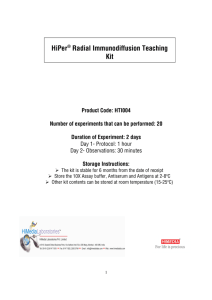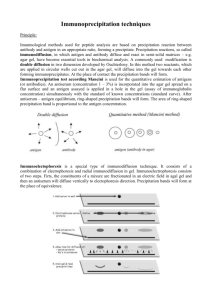Radial Immunodiffusion Teaching Kit Manual
advertisement
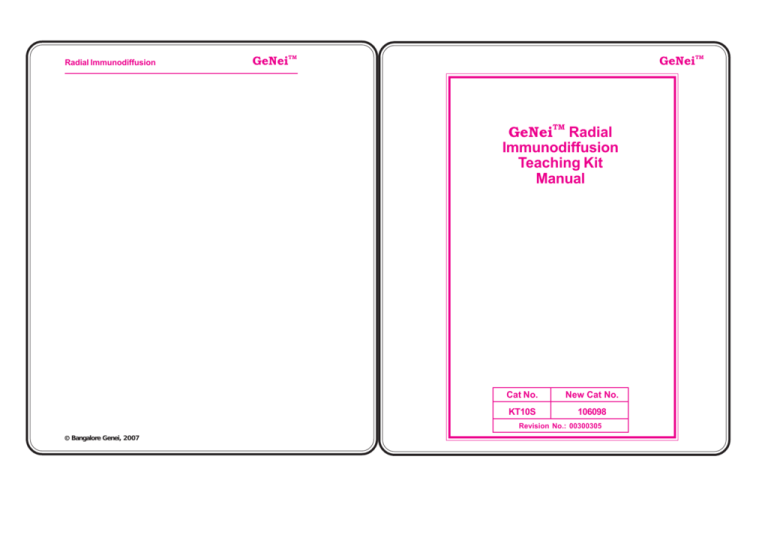
Radial Immunodiffusion GeNeiTM GeNeiTM Radial Immunodiffusion GeNeiTM Radial Immunodiffusion Teaching Kit Manual Cat No. New Cat No. KT10S 106098 Revision No.: 00300305 © Bangalore Genei, 2007 © Bangalore Genei, 2007 Radial Immunodiffusion GeNeiTM GeNeiTM Radial Immunodiffusion CONTENTS Page No. © Bangalore Genei, 2007 Objective 3 Principle 3 Kit Description 4 Materials Provided 5 Procedure 6 Result 9 Ordering Information © Bangalore Genei, 2007 1 10 GeNeiTM Radial Immunodiffusion GeNeiTM Radial Immunodiffusion Objective: To learn the technique of radial immunodiffusion. Principle: Single radial immunodiffusion (RID) is used extensively for the quantitative estimation of antigens. The antigenantibody precipitation is made more sensitive by the incorporation of antiserum in the agarose. Antigen (Ag) is then allowed to diffuse from wells cut in the gel in which the antiserum is uniformly distributed. Initially, as the antigen diffuses out of the well, its concentration is relatively high and soluble antigen-antibody adducts are formed. However, as Ag diffuses farther from the well, the Ag-Ab complex reacts with more amount of antibody resulting in a lattice that precipitates to form a precipitin ring. (Refer fig. 1). Fig.1: Standard RID Assay Thus, by running a range of known antigen concentrations on the gel and by measuring the diameters of their precipitin rings, a calibration graph is plotted. Antigen concentrations of unknown samples, run on the same gel can be found by measuring the diameter of precipitin rings and extrapolating this value on the calibration graph. © Bangalore Genei, 2007 2 © Bangalore Genei, 2007 3 GeNeiTM Radial Immunodiffusion GeNeiTM Radial Immunodiffusion Kit Description: Materials Provided: In this kit, standard antigen at four different concentrations (0.25 mg/ml, 0.5 mg/ml, 1.0 mg/ml and 2.0 mg/ml) are supplied along with two test antigen samples. These samples are allowed to diffuse in an agarose gel containing antiserum. Diameter of precipitin ring thus formed will be measured and plotted against the standard antigen concentrations to obtain a standard curve. Using this, the concentration of two test antigens will be determined. The list below provides information about the materials supplied in the kit. The products should be stored as suggested. Use the kit within 6 months of arrival. KT10S : The kit is designed to carry out 15 Radial immunodiffusion experiments Note : Sample of semi-log graph sheets are provided with the manual. Photocopy as required. Quantity Materials KT10S (15 expts.) Agarose Duration of the experiment: Experiment is carried out over a span of 2 days, approximate time taken on each day is indicated below: Day 1 : 1 hour (Preparation of gel and loading of antigen samples) Day 2 : 30 minutes (Observation and Interpretation) 10X Assay Buffer Store 2g 4°C 20 ml 4°C Standard Antigens* (A, B, C & D) 0.35 ml each 4°C Test Antigen* (1 & 2) 0.35 ml each 4°C Antiserum* 2 ml 4°C Gel Punch with syringe 1 No. 4°C Glass Plate 5 Nos. 4°C Template 2 Nos. 4°C *Supplied in lyophilized form, refer note for reconstitution. Materials Required: Glassware : Conical flask, Measuring cylinder. Reagents : Alcohol, Distilled water. Other Requirements : Micropipette, Tips, Moist chamber (box with wet cotton). © Bangalore Genei, 2007 4 © Bangalore Genei, 2007 5 GeNeiTM Radial Immunodiffusion Note: • • • • • • • • Read the entire procedure before starting the experiment. Dilute required amount of 10X assay buffer to 1X with distilled water. Reconstitute the antigen vials (standard and test) with 0.35 ml of 1X assay buffer. Mix well and store at 4°C. Use within 3 months. Reconstitute antiserum vial with 2 ml of 1X assay buffer. Mix well and store at 4°C.Use within 3 months. Wipe the glass plate with alcohol thoroughly to make it grease free for even spreading of agarose. Cut the wells neatly without rugged margins to get a perfect ring of precipitation. Add the antiserum to agarose only after it cools to 55°C. Higher temperature will inactivate the antibody. Assay buffer: Phosphate buffered saline. Procedure: 1. Prepare 10 ml of 1.0% agarose (0.1 g/10 ml) in 1X assay buffer by heating slowly till agarose dissolves completely. Take care not to scorch or froth the solution. 2. Allow the molten agarose to cool to 55°C. 3. Add 120 µl of antiserum to 6 ml of agarose solution. Mix by gentle swirling for uniform distribution of antibody. 4. Pour agarose solution containing the antiserum onto a grease free glass plate set on a horizontal surface. Leave it undisturbed to form a gel 5. Cut wells using a gel puncher as shown in figure 2, using the template provided. © Bangalore Genei, 2007 6 GeNeiTM Radial Immunodiffusion 6. Add 20 µl of the given standard antigens and test antigens to the wells as shown in figure 2. 2 1 3 4 5 6 Fig. 2 : Pattern of addition of standard antigen and test antigen samples to wells 1. 2. 3. 4. 5. 6. Standard Antigen A (0.25 mg/ml) Standard Antigen B (0.5 mg/ml) Standard Antigen C (1.0 mg/ml) Standard Antigen D (2.0 mg/ml) Test Antigen – 1 Test Antigen – 2 7. Keep the gel plate in a moist chamber (box containing wet cotton) and incubate overnight at room temperature. 8. Mark the edges of the circle and measure the diameter of the ring. Note down your observations as in table 1. 9. Plot a graph of diameter of ring (on Y-axis) versus concentration of antigen (on X-axis) on a semi-log graph sheet. 10. Determine concentration of unknown by reading the concentration against the ring diameter from the graph. © Bangalore Genei, 2007 7 GeNeiTM Radial Immunodiffusion GeNeiTM Radial Immunodiffusion For e.g., if following are the results obtained for an RID assay, plot the graph as shown in figure 3. 15 14 Std. Ag Conc. Ring Diameter (in mg/ml.) (in mm) A 0.25 6 B 0.5 8 C 1.0 10 D 2.0 12 Test sample 11 13 12 Ring diameter (mm) Sample No. 11 10 9 8 7 6 5 4 3 2 1 Table 1: Results of RID Assay 0 0.25 0.5 1 1.5 2 Antigen concentration (mg/ml) Fig. 3: Standard Curve for RID Assay From the graph, Concentration of antigen in test sample = 1.5 mg/ml Result: From the standard curve, determine and report concentration of antigen in the test samples. © Bangalore Genei, 2007 8 © Bangalore Genei, 2007 9 GeNeiTM Radial Immunodiffusion GeNeiTM Radial Immunodiffusion Ordering Information Product Size GeNeiTM Radial 1 Pack Immunodiffusion (RID) Teaching Kit (Consumables for 15 experiments) Cat # KT10S Email: Sales: geneisales@sanmargroup.com Customer Support: geneitechsupport@sanmargroup.com © Bangalore Genei, 2007 10 © Bangalore Genei, 2007 11 Radial Immunodiffusion Standard Curve for RID Assay © Bangalore Genei, 2007 GeNeiTM Radial Immunodiffusion Standard Curve for RID Assay © Bangalore Genei, 2007 GeNeiTM
